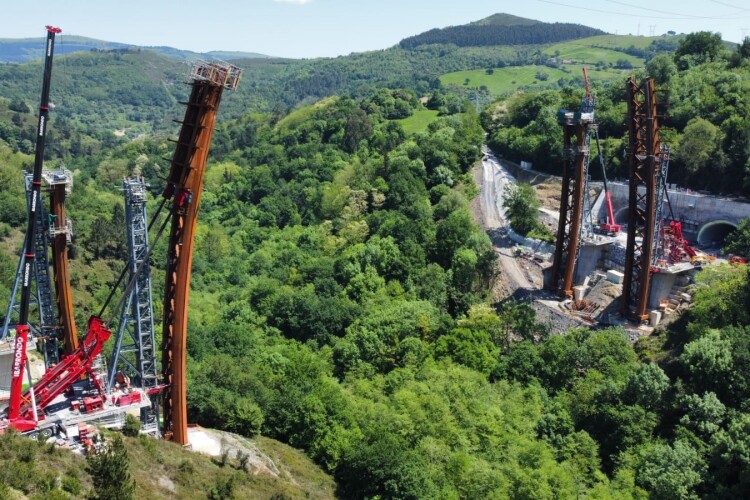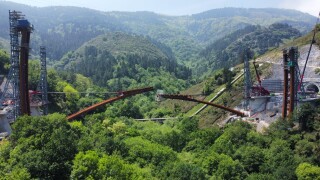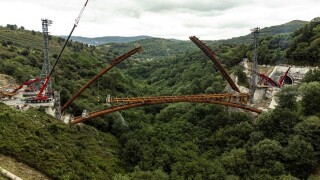The viaduct links road tunnels on either side of the Bolintxu valley, a protected area of natural beauty and ecological importance near the port of Bilbao.
The valley sits on the route of the new Supersur relief road which is being built so that traffic heading to the port can avoid travelling through the city.
Much of the Supersur is now complete and the viaduct over the Bolintxu valley is the last link in the chain. Because of the valley’s ecological importance, the client required that not only should any structure crossing it have minimal footprint, but also that the construction process should not intrude on the valley floor.
So instead of erecting temporary scaffold towers to support the viaduct during construction, it was decided to assemble each bridge arch in two sections, one on each side of the valley, and then slowly lower them down to meet in the middle.
Each semiarch was built upright, supported by a temporary scaffolding tower and mounted on top of a large swivel. Once both semiarches were completed, they were simultaneously tilted down and lowered, rotating on their swivels in a smooth and controlled strand jack operation.
“From the beginning we thought the lowering method could be an effective alternative,” said Alejandro Godoy, project manager for consulting engineer Arenas & Asociados.
“Being aware that Mammoet was able to deliver such operations having seen their work at the Alconetar Arches viaduct over the Tajo River and the Bolueta Arches over the Nervion River, for the City Metro of Bilbao, they were our first call to establish the best common approach.”
Although Mammoet has carried out similar operations, this project presented its own challenges, said Mammoet’s project manager, Veronica Arrayago.
“We recognised that moving such large components would present a challenge and demand some of Mammoet’s highest capacity strand jack equipment, especially as the final position of the bridges meant they would face very high tension loads," she said.
“However, we needed to be creative in the design of the equipment and where it was installed because the space between the tunnel openings and bridge abutments was extremely limited,” she continued. “The tunnels had to be used for tasks such as laying out strands as they were threaded into the jacking equipment.”

The tunnels were also the only access route in and out of the site and were used for other project activities at the same time, added Arrayago.
To install the viaduct arches, two bundles of steel cables were connected to an elevated section of each semiarch, which was then moved via strand jack to lower the section. The strand jacks were mounted on swiveling steel frames, designed and manufactured by Mammoet especially for the project, and anchored to a temporary foundation behind the abutment.
The massive forces that would be at play during the operation meant that multiple strand jacks would typically have been needed for each cable bundle, meaning additional steelwork, more groundwork and therefore more time and expense.
However, Arrayago said that Mammoet’s unique equipment inventory proved key in avoiding this, as Arrayago explains:
“Mammoet owns a number of 1,250-tonne strand jacks which are the largest in the world and unique to us having been custom designed to our specifications. They proved invaluable for the Bolintxu project as it allowed us to use fewer strand jacks for each arch, reducing time and cost for the client and making best use of the highly limited space on site.”
The operation began by breaking the static balanced position of the semiarches when they are still connected to the temporary scaffolding towers used for their construction. For this purpose, Mammoet used six push-pull cylinders of 64 tonnes capacity behind each arch to generate the sufficient force for the semiarch to start its way down into the valley.
Each bridge took between two and three days to successfully install. The first day was spent completing the slow and careful equilibrium-breaking process, while the remaining time was used to lower the component smoothly until it was in place ready to connect to the opposite side.
Got a story? Email news@theconstructionindex.co.uk





